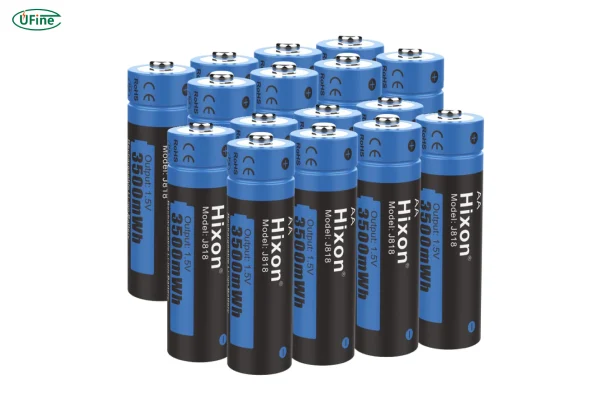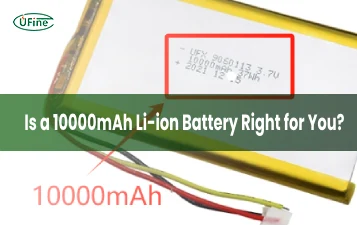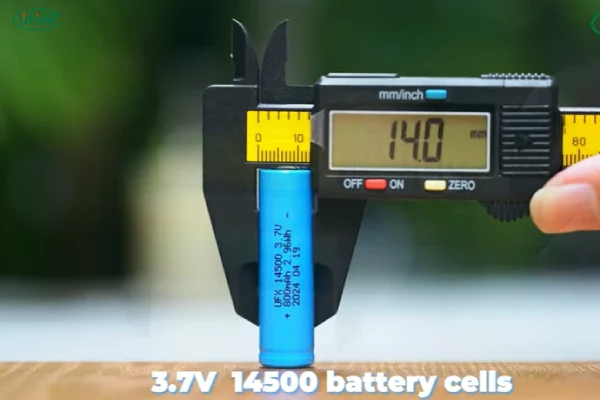Part 1. What is an AA size lithium battery?

A AA size lithium battery is a type of battery with the same dimensions as a standard AA battery but made with lithium chemistry. That means it packs more energy, lasts longer, and handles extreme temperatures better than regular alkaline AA batteries.
It’s often used in high-drain devices—things that need a lot of power fast. Think digital cameras, GPS devices, or medical equipment.
Part 2. Size and shape
An AA battery is 14.5 mm in diameter and 50.5 mm in length. That’s standard.
So when we say “AA size,” we’re talking about batteries that will fit any device made for standard AA cells. But lithium AA batteries sometimes weigh less, which is a bonus for portable devices.
The shape is the same—cylindrical. So you don’t need to worry about fit.
Part 3. Voltage and capacity
Here’s where things get interesting.
- Non-rechargeable AA lithium batteries usually have 1.5V output.
- Rechargeable lithium AA batteries can be 3.6V or 3.7V, depending on the type.
- Some newer lithium-ion AA batteries are made with built-in voltage regulators to match 1.5V output.
And what about capacity?
- Non-rechargeable AA lithium batteries: 2,700–3,000mAh.
- Rechargeable AA lithium-ion batteries: 600–1,200mAh (they’re smaller due to internal circuits).
Higher voltage means more power. But always check what your device needs before switching.
Part 4. Chemical type
Not all lithium AA batteries are created equal. Here are the main types:
- Li-FeS2 (Lithium Iron Disulfide): These are the most common non-rechargeable AA lithium batteries. They’re great for cameras and cold-weather devices.
- Li-ion (Lithium-ion): Rechargeable and powerful, but typically 3.6V or 3.7V. Use with care in devices not designed for them.
- Li-SOCl2 (Lithium Thionyl Chloride): Used in industrial or IoT applications. Very long shelf life. Usually not for consumer use.
- Li-MnO2 (Lithium Manganese Dioxide): Also found in specialized or high-demand electronics.
So before buying, know the chemistry. It matters.
Part 5. AA size lithium battery cell and pack
You’ll find single-cell AA lithium batteries for most consumer devices.
But for industrial or custom uses, AA-size lithium battery packs are common too. These packs combine several AA cells into a unit—usually wired in series (to increase voltage) or parallel (to increase capacity).
For example, a 4-cell pack might provide 6V total if each cell is 1.5V. Packs can also be custom-built for specific machines or electronics.
Ufine Battery, a leading lithium battery manufacturer in China, specializes in custom lithium battery packs—including AA-size lithium batteries. Whether you need higher voltage, unique connectors, or industrial-grade stability, Ufine offers tailored solutions for your specific needs.
Need custom AA-size lithium batteries? Contact Ufine Battery for a quote.
Part 6. Rechargeable and non-rechargeable AA size lithium batteries
Let’s break down the differences.
Non-Rechargeable (Primary):
- Voltage: 1.5V
- Capacity: 2,700–3,000mAh
- Shelf life: Up to 10 years
- Common brands: Energizer Ultimate Lithium, Duracell Lithium
- Use case: Cameras, flashlights, outdoor devices
Rechargeable (Secondary):
- Voltage: 3.6V or 3.7V (some regulated to 1.5V)
- Capacity: 600–1,200mAh
- Recharge cycles: 500–1,000
- Use case: High-drain electronics, RC toys, medical tools
The Difference Between Primary and Secondary Battery
Rechargeables save money long term but require compatible chargers. Use caution if your device can’t handle higher voltages.
Part 7. AA size lithium battery vs. 14500 battery: what’s the difference?
At first glance, AA size lithium batteries and 14500 lithium-ion batteries look nearly identical. Both share the same cylindrical shape, and both measure approximately 14.5mm in diameter and 50.5mm in length. So it’s easy to assume they’re interchangeable.
All About 14500 Lithium Rechargeable Battery
But in reality, these two battery types are fundamentally different—and using one in place of the other could damage your device.
Let’s break down the key differences:
1. Voltage Output
- AA lithium batteries (non-rechargeable) typically output 1.5V, just like regular alkaline batteries.
- 14500 batteries (rechargeable lithium-ion) usually output 3.6V or 3.7V, which is more than double the voltage of a standard AA.
Why it matters:
If you insert a 14500 battery into a device designed for 1.5V AA batteries, you risk overvolting the electronics, which can cause overheating or permanent damage.
2. Rechargeability
- Most AA size lithium batteries on the market are non-rechargeable (like lithium iron disulfide).
- 14500 batteries are always rechargeable and behave similarly to 18650 lithium-ion cells, just smaller.
Don’t recharge a regular AA lithium battery unless it’s clearly marked as rechargeable. Only 14500 cells should be placed in a lithium-ion charger.
3. Application Use Case
- AA lithium batteries are perfect for consumer devices like remote controls, cameras, smoke alarms, and toys that require 1.5V input.
- 14500 batteries are more commonly found in flashlights, vape devices, DIY electronics, and IoT systems that are built to handle 3.7V input.
4. Labeling and Safety
Unfortunately, some brands market 14500 batteries as “AA lithium” because of the size similarity. But this can be misleading and dangerous. Always check:
- The voltage on the label
- Whether it’s rechargeable
- The capacity (mAh) and chemistry
A true 14500 battery will always say 3.6V/3.7V and typically have higher energy output but lower cycle life than standard rechargeable NiMH AAs.
Part 8. How do I know what size lithium battery I need?
Great question! Here’s how:
- Check your device manual. It usually lists battery requirements.
- Look at your current battery. Match the size, voltage, and type.
- Check the voltage range your device can handle. Don’t put a 3.7V battery in a 1.5V-only device!
- Match the chemistry. If your device says use “Li-FeS2”, don’t swap in a Li-ion without checking compatibility.
- For custom electronics, talk to your battery supplier—like Ufine Battery—for expert advice.
Don’t guess. A wrong battery could damage your device.
Part 9. Conclusion: Is AA size lithium battery worth it?
Yes, 100%. If you need reliable power, long life, or lightweight performance, AA size lithium batteries are a solid upgrade from regular AA batteries. They’re ideal for high-drain devices, cold environments, and industrial tools.
Just remember:
- Match the voltage and chemistry.
- Choose rechargeable or non-rechargeable based on your use.
- And if you need something specific? Go custom.
Ufine Battery can help you find or design the perfect lithium battery for your needs. They specialize in custom lithium solutions, including AA size, LiFePO4, 18650, high-rate, and high-temperature batteries.
Contact Ufine Battery today for expert help and a free quote.
Part 10. FAQs
Can I use AA lithium batteries instead of alkaline?
Yes, if your device supports it. Lithium lasts longer and performs better in cold weather. But double-check voltage compatibility.
Are all AA lithium batteries rechargeable?
No. Most AA lithium batteries sold in stores (like Energizer Lithium) are non-rechargeable. Rechargeable lithium-ion AA batteries are a separate category.
Can I charge AA lithium batteries with a regular charger?
Only if they’re rechargeable and the charger is designed for lithium cells. Never charge a non-rechargeable lithium battery. It can be dangerous.
Why are lithium AA batteries more expensive?
They last longer, weigh less, and work in harsh conditions. That added performance comes at a higher upfront cost—but they save money over time.
Where can I buy custom AA size lithium battery packs?
Ufine Battery offers high-quality custom lithium battery solutions, including AA-size cells and packs. You can request custom voltages, capacities, and more.
Related Tags:
More Articles

10000mAh Battery Explained: How Long It Lasts, How It Works
A full guide on 10000mAh li-ion batteries, voltage, usage time, and tips. Discover how a 10000mAh battery works, how long it lasts, and how to choose.
10440 Battery Guide: Size, Voltage, Capacity, Uses & More
Understand 10440 batteries better—size, voltage, safety, and how they compare to AAA. Find the best fit for your high-performance devices.
White Stuff on Battery Terminals: A Step-by-Step Cleaning and Maintenance Guide
White stuff on battery terminals is corrosion. Learn how to clean it safely, prevent damage, and keep your battery running strong with simple steps.
Understanding How Glass Mat Batteries Work: Technology, Benefits, and Limitations
Glass mat batteries power cars, RVs, and solar systems. Learn how they work, their benefits, and what to consider before choosing one.
Li-Ion Battery Prices – Where to Buy Cheap & Safe
Discover li-ion cell prices, key market factors, and how to find affordable custom batteries from top suppliers like Ufine Battery.




